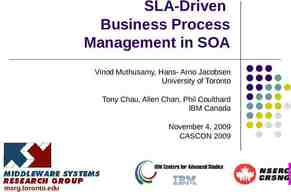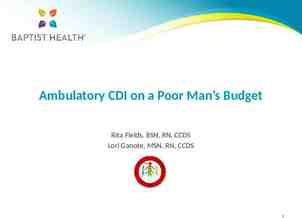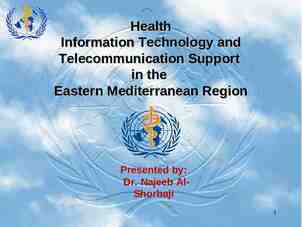Public Health 101 Series Introduction to Epidemiology Instructor name
61 Slides5.59 MB

Public Health 101 Series Introduction to Epidemiology Instructor name Title Organization Note: This slide set is in the public domain and may be customized as needed by the user for informational or educational purposes. Permission from the Centers for Disease Control and Prevention is not required, but citation of the source is appreciated.

Course Topics Introduction to Epidemiology 1. 2. 3. 4. 5. 6. 7. A Public Health Approach What Is Epidemiology? Key Concepts and Terms Calculating Rates Approach and Methodology Data Sources and Study Design Investigating an Outbreak 2

Learning Objectives After this course, you will be able to define epidemiology describe basic terminology and concepts of epidemiology identify types of data sources identify basic methods of data collection and interpretation describe a public health problem in terms of time, place, and person identify the key components of a descriptive epidemiology outbreak investigation 3

Topic 1 A Public Health Approach 4

A Public Health Approach Surveillance Risk Factor Identification Intervention Evaluation Implementation 5

Public Health Core Sciences 6

Topic 2 What Is Epidemiology? 7

Epidemiology — Defined Study of the distribution and determinants of health-related states among specified populations and the application of that study to the control of health problems Adapted from: Last JM, ed. A dictionary of epidemiology. 2nd ed. Toronto, Canada: Oxford University Press; 1988. 8

Epidemiology Purposes in Public Health Practice Discover the agent, host, and environmental factors that affect health Determine the relative importance of causes of illness, disability, and death Identify those segments of the population that have the greatest risk from specific causes of ill health Evaluate the effectiveness of health programs and services in improving population health 9

Solving Health Problems Step 1 Step 1 Data collection Solving health problems Step 4 Action Action Step 1 - Surveillance; determine time, place, and person Step 2 Assessment Step 2 Inference Step 3 Hypothesis testing Step 3 Determine how and why Step 4 Intervention 10

Knowledge Check All of the following illustrate the purpose of epidemiology in public health, except A. identifying populations who are at risk for certain diseases. B. assessing the effectiveness of interventions. C. providing treatment for patients in clinical settings. D. determining the importance of causes of illness 11

Knowledge Check Epidemiologists use a model for studying infectious disease and its spread that involves the microbe that causes the disease, the organism that harbors the disease, and the external factors that cause or allow disease transmission. This is also known as A. host, vector, and transmission. B. transmission, host, and environment. C. host, agent, and environment. D. organism, transmission, and environment. 12

Topic 3 Epidemiology Key Terms 13

Epidemiology Key Terms epidemic or outbreak: disease occurrence among a population that is in excess of what is expected in a given time and place. cluster: group of cases in a specific time and place that might be more than expected. endemic: disease or condition present among a population at all times. pandemic: a disease or condition that spreads across regions. rate: number of cases occurring during a specific period; always dependent on the size of the population during that period. 14

Knowledge Check Match each term with the correct example. A. endemic A. endemic B. pandemic C. epidemic 1. Malaria is present in Africa at all times because of the presence of infected mosquitoes. Malaria is in Africa. C. epidemic 2. The Ebola virus in parts of Africa is in excess of what is expected for this region. This virus is a/an . B. pandemic 3. HIV/AIDS is one of the worst global diseases in history. It is a/an . 15

Knowledge Check Choose the correct answer. A. distribution B. cluster C. determinant In March 1981, an outbreak of measles occurred among employees at Factory X in Fort Worth, Texas. This group of cases in this cluster specific time and place can be described as a . 16

Topic 4 Calculating Rates 17

Comparing Population Characteristics Rates help us compare health problems among different populations that include two or more groups who differ by a selected characteristic 18

Rate Formula To calculate a rate, we first need to determine the frequency of disease, which includes the number of cases of the illness or condition the size of the population at risk the period during which we are calculating the rate 19

Scenario: Unexplained Pneumonia American Legion Convention, Philadelphia, Pennsylvania July 21–24 Health care provider at a veterans’ hospital in Philadelphia calls CDC to report cases of severe respiratory illness among attendees of the American Legion Convention July 26–Aug 1 18 deaths reported among conventioneers August 2 (Morning) August 2 (Evening) 71 additional cases reported Fraser DW, Tsai, T, Orenstein W, et al. Legionnaires’ disease: description of an epidemic of pneumonia. New Engl J Med 1977;297:1189–97. 20

Legionnaires’ Disease, by Age Group Hotel A Residents Time: July 21–24, 1976 Age (yrs) Frequency Unit size Sick Total Percentag e 39 3 44 6.8 40–49 9 160 5.6 50–59 27 320 8.4 60–69 12 108 11.1 70 11 54 20.4 Unknown 0 2 0 Fraser DW, Tsai, T, Orenstein W, et al. Legionnaires’ disease: description of an epidemic of pneumonia. New Engl J Med 1977;297:1189–97. 21

Legionnaires’ Disease Rate Hotel A Residents Time: July 21–24, 1976 Age (yrs) Frequency Unit Rate Sick Total Percentag e 39 3 44 6.8 40–49 9 160 5.6 50–59 27 320 8.4 60–69 12 108 11.1 70 11 54 20.4 Unknown 0 2 0 22

Knowledge Check On Day 1 of a technology conference in San Diego, 15 presenters who were setting up for their sessions in Annex X became ill with flu-like symptoms. During the course of the conference, 20 participants who attended sessions in Annex X also became ill with the same symptoms. To begin calculating the rate of this outbreak, investigators should first determine A. the size of the conference population. B. the number of cases of illness. C. the number of days the conference was held. D. the location of the conference. 23

Topic 5 Epidemiology Approach and Methods 24

Epidemiology Study Types Experimenta Epidemiolog y study types l Descriptive Observation al Analytic 25

Descriptive and Analytic Epidemiology Descriptive epidemiology Analytic epidemiology When was the population affected? How was the population affected? Where was the population affected? Why was the population affected? Who was affected? 26

Fatalities Associated with Farm Tractors In 1982, the number of farm tractor-associated deaths was described in terms of time, place, and person by using records from an existing surveillance system 27

Fatalities Associated with Farm Tractors Goodman RA, Smith JD, Sikes RK, et al. Fatalities associated with farm tractor injuries: an epidemiologic study. Public Health Rep 1985;100:329–33. 28

Fatalities Associated with Farm Tractors Goodman RA, Smith JD, Sikes RK, et al. Fatalities associated with farm tractor injuries: an epidemiologic study. Public Health Rep 1985;100: 329–33. 29

Fatalities Associated with Farm Tractors Goodman RA, Smith JD, Sikes RK, et al. Fatalities associated with farm tractor injuries: an epidemiologic study. Public Health Rep 1985;100:329–33. 30

Knowledge Check Choose the correct answer from the following choices: A. Qualitative B. Experimental C. Observational C. Observational An epidemiologist is doing a study on the sleep patterns of college students but does not provide any intervention. What type of study is this? 31

Knowledge Check Match each term to the correct example below. A. Descriptive B. Analytic B. Analytic 1. A study of heart disease comparing a group who eats healthy foods and exercises regularly with one who does not in an effort to test association A. Descriptive 2. A study to describe the eating habits of adolescents aged 13–18 years in Community X 32

Topic 6 Epidemiology Data Sources and Study Design 33

Data Sources and Collection Methods Source Individual persons Method Questionnaire Survey Example Environment Samples from the environment (river water, soil) Sensors for environmental changes Foodborne illness outbreak CDC’s National Health and Nutrition Examination Survey Health data on U.S. residents Collection of water from area streams — check for chemical pollutants Air-quality ratings Health care providers Notifications to health department if cases of certain diseases are observed Report cases of meningitis to health department Nonhealth–related sources (financial, legal) Sales records Court records Cigarette sales Intoxicated driver arrests 34

Conducting Studies Studies are conducted in an attempt to discover associations between an exposure or risk factor and a health outcome 35

Study Design — Cross-Sectional Study Subjects are selected because they are members of a certain population subset at a certain time 36

Study Design — Cohort Study Subjects are categorized on the basis of their exposure to one or more risk factors 37

Study Design Type — Case-Control Study Subjects identified as having a disease or condition are compared with subjects without the same disease or condition 38

Knowledge Check Which of the following are examples of a healthrelated source of data collection? A. Intoxicated driver arrests. B. Electronic health records. C. Measurement of toxins in a river. D. Medical board action against a physician. 39

Knowledge Check Match each study with the correct definition. A. Cross-Sectional C. Case-Control B. Cohort C. Case-Control 1. Subjects with diabetes are compared with subjects without diabetes. A. Cross-Sectional 2. A study of women aged 50–60 years in a community located close to a nuclear power facility. B. Cohort 3. Subjects who have received nutritional counseling and who have exercised twice a week are compared with subjects who have not. 40

Topic 7 Investigating an Outbreak 41

Outbreak Investigation Ten steps are involved in outbreak investigations, including establishing the existence of an outbreak preparing for fieldwork verifying the diagnosis defining and identifying cases using descriptive epidemiology developing hypotheses evaluating the hypotheses refining the hypotheses implementing control and prevention measures communicating findings 42

Outbreak Investigation — Steps 1 and 2 Step 1 — Establishing the existence of an outbreak Use data from data sources Step 2 — Preparing for field work Research the disease Gather supplies and equipment Arrange travel Fraser DW, Tsai, T, Orenstein W, et al. Legionnaires’ disease: description of an epidemic of pneumonia. New Engl J Med 1977;297 1189–97. 43

Outbreak Investigation — Steps 3 and 4 Step 3 — Verifying the diagnosis Speak with patients Review laboratory findings and clinical test results Step 4 — Defining and identifying cases Establish a case definition by using a standard set of criteria Fraser DW, Tsai, T, Orenstein W, et al. Legionnaires’ disease: description of an epidemic of pneumonia. New Engl J Med 1977;297 1189–97. 44

Outbreak Investigation — Step 5 Step 5 — Using descriptive epidemiology Describe and orient the data Fraser DW, Tsai, T, Orenstein W, et al. Legionnaires’ disease: description of an epidemic of pneumonia. New Engl J Med 1977;297 1189–97. 45

Legionnaires’ Disease Cases, by Day Fraser DW, Tsai, T, Orenstein W, et al. Legionnaires’ disease: description of an epidemic of pneumonia. New Engl J Med 1977;297:1189–97. 46

Legionnaires’ Disease Attack Rates Hotel A Age (yrs) Hotel B Hotel C Ill Total Percent ill Ill Total Percent ill Ill Total Percent ill 39 3 44 6.8 3 116 2.6 6 160 3.7 40–49 9 160 5.6 11 232 4.7 20 392 5.1 50–59 27 320 8.4 25 523 4.8 52 843 6.2 60–69 12 108 11.1 19 207 9.1 31 315 9.8 70 11 54 20.4 5 76 6.5 16 130 12.3 0 2 0 0 7 0 0 9 0 62 688 9.0 63 1,161 5.4 125 1,849 6.8 Unknow n Total Fraser DW, Tsai, T, Orenstein W, et al. Legionnaires’ disease: description of an epidemic of pneumonia. New Engl J Med 1977;297: 1189–97. 47

Outbreak Investigation — Steps 6, 7, and 8 Step 6 — Develop a focused hypothesis Step 7 — Evaluate the hypothesis for validity Step 8 — Refine the hypothesis as needed Fraser DW, Tsai, T, Orenstein W, et al. Legionnaires’ disease: description of an epidemic of pneumonia. New Engl J Med 1977;297:1189–97. 48

Legionnaires’ Disease Study Results Five months after the first cases of Legionnaires’ disease occurred, results of the casecontrol study indicated that spending time in the lobby of Hotel A was a risk factor for illness 49

Legionnaires’ Disease Study Results In December 1976, a CDC laboratorian successfully located the source bacteria after continuing to test the specimens that were thought to be dead 50

Outbreak Investigation — Steps 9 and 10 Step 9 — Implement control and prevention measures Control and prevent additional cases Step 10 — Communicate findings Determine who needs to know Determine how information will be communicated Identify why the information needs to be communicated Fraser DW, Tsai, T, Orenstein W, et al. Legionnaires’ disease: description of an epidemic of pneumonia. New Engl J Med 1977;297:1189–97. 51

Knowledge Check In 1976, during an American Legion Convention, 11 attendees had died of apparent heart attacks by August 1. Dr. Campbell contacted the Pennsylvania Department of Health after realizing he had treated 3 of those 11 attendees. What is the first step the Pennsylvania Department of Health should have followed? A. Establish a surveillance system. B. Alert the convention attendees. C. Establish the existence of an outbreak. D. Send an investigation team to the hotel. 52

Knowledge Check CDC then launched an investigation. However, no effective communication existed between scientists in the field interviewing patients and those in the laboratory who were testing specimens. As a first step in stopping this outbreak, what should the team have done to identify persons who were part of the outbreak? A. Verify a diagnosis. B. Establish a case definition to identify cases. C. Communicate findings to the public. D. Implement prevention measures. 53

Knowledge Check In speculating that the cooling system might be the source of the outbreak, what step was the epidemiologist implementing? A. Developing a hypothesis. B. Refining a hypothesis. C. Evaluating a hypothesis. D. Verifying a diagnosis. 54

Knowledge Check In January 1977, the Legionella bacterium was finally identified and isolated and was found to be breeding in the cooling tower of the hotel’s air-conditioning system; the bacteria then spread through the building whenever the system was engaged. What should the investigation team do regarding their original hypothesis? A. Evaluate it. B. Refine it. C. Confirm it. D. Both A and B. 55

Knowledge Check The finding from this outbreak investigation lead to development of new regulations worldwide for climate control systems. What step does this illustrate? A. Communicate the findings. B. Implement control and prevention measures. C. Perform descriptive epidemiology. D. Refine the hypothesis. 56

Course Summary During this course, you learned to define epidemiology describe basic terminology and concepts of epidemiology identify types of data sources identify basic methods of data collection and interpretation describe a public health problem in terms of time, place, and person identify the key components of a descriptive epidemiology outbreak investigation 57

QUESTIONS? 58

Resources and Additional Reading Bogdanich W. Panama releases report on ‘06 poisoning. The New York Times, February 14, 2008.http://www.nytimes.com/2008/02/14/world/americas/14panama.html. Centers for Disease Control and Prevention (CDC). CDC helps solve Panama mystery illness. Atlanta, GA: US Department of Health and Human Services, CDC News, October 7, 2006. http://www.cdc.gov/news/2006 10/panama.htm. Dean H. Introduction to public health, epidemiology, and surveillance. Atlanta, GA: US Department of Health and Human Services, CDC Science Ambassador Program, July 16, 2012. Fraser DW, Tsai, T, Orenstein W, et al. Legionnaires’ disease: description of an epidemic of pneumonia. New Engl J Med 1977;297:1189–97. Goodman RA, Smith JD, Sikes RK, et al. Fatalities associated with farm tractor injuries: an epidemiologic study. Public Health Rep 1985;100:329–33. Centers for Disease Control and Prevention (CDC). How to investigate an outbreak. Epidemiology in the Classroom, November 17, 2004. Atlanta, GA: US Department of Health and Human Services, CDC. http://www.cdc.gov/excite/classroom/outbreak/steps.htm#step1. Last JM, ed. A dictionary of epidemiology. 2 nd ed. Toronto, Canada: Oxford University Press; 1988. Rentz DE, Lewis L, Mujica OJ, et al. Outbreak of acute renal failure in Panama in 2006: a case-control study. Bull World Health Organ 2008;86:749–56. Sakamoto R, Ohno A, Nakahara T, et al. Legionella pneumophilia in rainwater on roads. Emerg Infect Dis 2009;15:1295–7. Thacker SB, Birkhead GS. Surveillance [Chapter 3]. In: Gregg, MB, ed. Field epidemiology. 3rd ed. New York, NY: Oxford University Press; 2008. 59

Disclaimers Links provided in this course to nonfederal organizations are provided solely as a service to our users. These links do not constitute an endorsement of these organizations nor their programs by the Centers for Disease Control and Prevention (CDC) or the federal government, and none should be inferred. CDC is not responsible for the content contained at these sites. Use of trade names and commercial sources is for identification only and does not imply endorsement by the Division of Scientific Education and Professional Development, Center for Surveillance, Epidemiology, and Laboratory Services, Centers for Disease Control and Prevention, the Public Health Service, or the U.S. Department of Health and Human Services. The findings and conclusions in this course are those of the authors and do not necessarily represent the official position of the Centers for Disease Control and Prevention. 60

For more information, please contact the Centers for Disease Control and Prevention 1600 Clifton Road NE, Atlanta, GA 30333 Telephone: 1-800-CDC-INFO (232-4636)/TTY: 1-888-232-6348 Visit: http://www.cdc.gov Contact CDC at: 1-800-CDC-INFO or http://www.cdc.gov/info The findings and conclusions in this course are those of the authors and do not necessarily represent the official position of the Centers for Disease Control and Prevention. Center for Surveillance, Epidemiology, and Laboratory Services Division of Scientific Education and Professional Development






